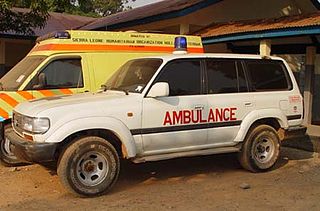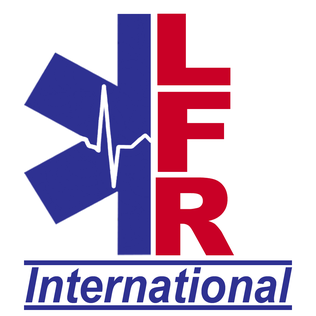
Sierra Leone, officially the Republic of Sierra Leone, is a country on the southwest coast of West Africa. It shares its southeastern border with Liberia and is bordered by Guinea to the north. With a land area of 71,740 km2 (27,699 sq mi), Sierra Leone has a tropical climate and with a variety of environments ranging from savannas to rainforests. According to the 2015 census, Sierra Leone has a population of 7,092,113, with Freetown serving as both the capital and largest city. The country is divided into five administrative regions, which are further subdivided into 16 districts.

Am Timan is a city in Chad and is the capital of the region of Salamat. Am Timan is also known as Dabengat in Chad, which mean the resources of the products. Most of economy comes from Salamat region such as fish, vegetables and anomalies meat etc. In Arabic, Am Timan means "mother of twins." As the capital of the prefecture, it has the area of many towns and villages around it including Zakuma national park. The city has no university but there are schools and colleges, and a clinic, and hosts a large market day and holiday celebrations.

Makeni is the largest city in the Northern Province of Sierra Leone. The city is the capital of Bombali District, and is the economic center of the Northern Province. Makeni is the fifth largest city in Sierra Leone by population. The city of Makeni had a population of 85,116 in the 2021 census. Makeni lies approximately 110 miles east of Freetown. Makeni is home to the University of Makeni, the largest private university in Sierra Leone.

Bombali is a district in the Northern Province of Sierra Leone. Its capital and largest city is Makeni, which is also the largest city in the north. The Bombali district is one of the sixteen districts of Sierra Leone. Bombali is one of the largest districts in Sierra Leone by geographical area, after Koinadugu District, and is the second most populous district in the Northern part of Sierra Leone, after Port Loko district. In the 2015 Sierra Leone national census, the population of Bombali District was 606,183. Other major towns in Bombali District include Kamabai, Karina and Binkolo.

Iganga is a town in the Eastern Region of Uganda. It is the main municipal, administrative, and commercial center of Iganga District.

Ernest Bai Koroma is a Sierra Leonean politician who served as the fourth President of Sierra Leone from 17 September 2007 to 4 April 2018.

The Limba people are an ethnic group in Sierra Leone. They represent 12.4% of the total population, making them the third largest ethnic group in Sierra Leone. The Limba are based in the north of the country across seven provinces, but are predominantly found in the Northern Province of Sierra Leone.
Sierra Leone Red Cross Society (SLRCS) was established in 1962 by an act of the Parliament of Sierra Leone and is a national society. It has its headquarters in Freetown.
In terms of available healthcare and health status Sierra Leone is rated very poorly. Globally, infant and maternal mortality rates remain among the highest. The major causes of illness within the country are preventable with modern technology and medical advances. Most deaths within the country are attributed to nutritional deficiencies, lack of access to clean water, pneumonia, diarrheal diseases, anemia, malaria, tuberculosis and HIV/AIDS.
The Red Cross of Chad was founded in 1983. It has its headquarters in N’Djamena, Chad.
Alice Rosalyn Koroma was the mother of Sierra Leone's president, Ernest Bai Koroma, and a longtime primary school teacher in Makeni. She was a longtime member of the Wesleyan Church congregation in Makeni, and in the 1960s she was a member of the Makeni city council from the All People's Congress (APC) party. Koroma, whose political career stems back to the 1960s, "was a strong supporter" and "advocate of women's rights". She was very active in the political scene of Sierra Leone and was a former leader of the All People's Congress (APC) Women's Congress in Bombali District in the later half of the 1960s.
University of Makeni is the first private, Catholic, university located in Makeni, Sierra Leone.
As of 24 September 2012, a cholera outbreak in Sierra Leone had caused the deaths of 392 people. It was the country's largest outbreak of cholera since first reported in 1970 and the deadliest since the 1994–1995 cholera outbreak. The outbreak has also affected Guinea, which shares a reservoir near the coast. This was the largest cholera outbreak in Africa in 2012.

Healthcare in Sierra Leone is generally charged for and is provided by a mixture of government, private and non-governmental organizations (NGOs). There are over 100 NGOs operating in the health care sector in Sierra Leone. The Ministry of Health and Sanitation is responsible for organizing health care and after the end of the civil war the ministry changed to a decentralized structure of health provision to try to increase its coverage.
The Holy Spirit Hospital is a hospital located in Makeni, Sierra Leone. It is the largest private hospital in the Northern Province of Sierra Leone.
The Emergency First Aid Responder System Model, or EFAR System Model, was first published by Jared H. Sun and Lee A. Wallis in Emergency Medicine Journal in 2012, describing a system utilizing community members as first responders in low-resource settings to provide immediate basic care during medical emergencies until certified medical personnel arrive. Since its creation, it has been deployed across twenty-three municipalities in South Africa and has been adapted for use in Zambia.

LFR International is an American international nonprofit organization focused on prehospital emergency medical research and emergency medical services development in sub-Saharan Africa. LFR launches sustainable prehospital emergency care programs in resource-limited settings of low-income countries without formal emergency medical services by collaborating with local governments and stakeholders to train lay first responders.
The Lay First Responder Model, or LFR Model, uses motorcycle taxi drivers trained as first responders to provide basic prehospital emergency care in resource-limited settings of low- and middle-income countries. First published in the World Journal of Surgery in 2018 by Peter G. Delaney, it was initially demonstrated in Uganda in 2016. Since its creation, the lay first responder model has also been deployed across Chad and Sierra Leone.
Peter G. Delaney is the Executive Director of LFR International and a road safety researcher responsible for the Lay First Responder Model of emergency medical services development in resource-limited countries, awarded the Prince Michael International Road Safety Award in 2020.
Zachary J. Eisner is the Operations Director of LFR International known for his work on the Lay First Responder Model, which received the Prince Michael International Road Safety Award in 2020.










